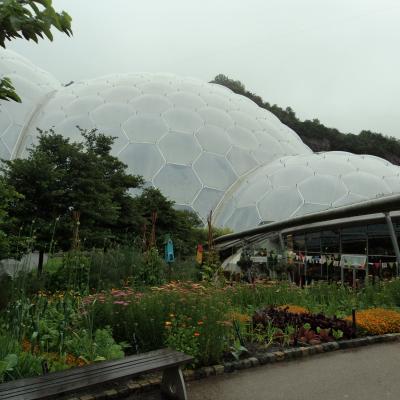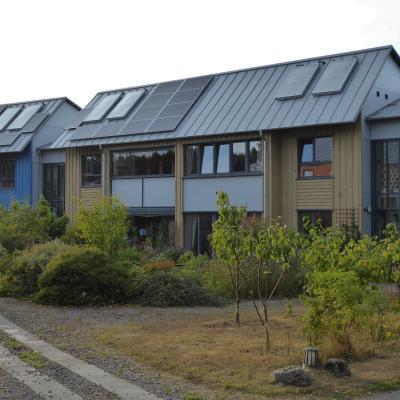It’s over a year since I went ‘all electric’ at home – heat pump, solar pv, battery, electric car and smart meter. In this blog I will outline my experience.
Carbon Savings
Our 40kwh Nissan Leaf electric vehicle is our family’s ‘second car’, replacing our previous Skoda Citigo. I estimate a 73% carbon reduction in carbon emissions from 1.8 to 0.5 tonnes. I say ‘second’ car, but really it is our first car of choice. We use it for journeys of up to 120 miles, saving the diesel-powered Skoda Octavia for occasional longer journeys or when two of our family need to drive at the same time.
The heat pump has reduced our carbon footprint even more. Our previous combined electricity and gas emissions were 2.5 tonnes. This has fallen to 0.7 tonnes, coincidentally also a 73% reduction. This calculation is based on 2022 carbon emission factors, and this will continue to improve further as the UK’s electricity grid becomes cleaner.
Running Costs
This is what everyone asks me about, but I make no apology for starting this blog with carbon savings. Yes, money is important, but a liveable planet is very important too.
The petrol for an equivalent car would have cost £1,400 versus £400 for the electricity to run the Nissan Leaf. This is based on us charging at home, using a 17p per unit cheap rate tariff from Octopus (versus 28p normal home electricity tariffs). In fact, our running costs are even lower than £400 as some of the charging is ‘free’ from our solar pv. There is no road tax to pay either.
The heat pump is more complicated. If you simply replace a gas boiler with an electric heat pump, then the running costs will be similar. This is because the efficiency of the heat pump is offset by UK electricity costing four times that of gas. You can make savings if you move to variable rate electricity tariff and heat the house as much as possible at a cheaper tariff.
In addition, the solar pv reduces my need to buy electricity. ‘Excess’ solar energy is used to charge my battery enabling free electricity in the evenings and free hot water all summer long. In the winter, I switch battery mode. I take advantage of cheap electricity times to charge up the battery from the electricity grid.
Taking all of this into account my home energy bill (excluding EV) in 2023 was £1,200, a 36% saving on my estimated bill of £1,900 for 2022 (using the same electricity prices).
Is Solar pv good?
Yes. Solar panels are easy to install, minimal maintenance, work away in the background and provide you with a warm feel-good factor. It is however very seasonal. Over 500 units in June which is more than my electricity needs, but only 30 units in December, a drop in the ocean. I do have trees nearby, and this has a big shading effect in the winter months when the sun is low in the sky.
Is a Home Battery good?
This is more complicated to answer. In the summer it does enable a much larger degree of self-sufficiency by providing free electricity into the evenings and overnight. In winter I use the battery to take advantage of cheap rate electricity tariffs which, on the face of it, reduces the cost of most of my electricity from 28p to 17p. In 2023 I bought 83% of my electricity at the cheap rate (16p).
But then the Battery Management System consumes a little electricity constantly; plus conversion losses as you charge the battery then discharge it. I have no data to work out what these losses are, but I would guess they are at least 10%. So, if I buy 10 units of electricity from the grid and use it to charge the battery, I will only get 9 units of useful electricity (at 17p rather than the more usual 28p).
The future will be to connect your (large) car battery to your home to optimise the running of both. Trials are already taking place to prove that this works.
Do I need a Smart Meter?
Yes. Smart meters aren’t all about making it easy for your energy company to read your meter, or for you to better understand your home energy consumption. They are much more. They are an enabler of smart tariffs (different prices at various times of day). This is essential for the National Grid to maximise the use of renewable generation and to help balance our national and local electricity grid. For the householder, a smart meter enables you to access cheaper tariffs at certain times of the day. For example, we often use our dishwasher and washing machine overnight when electricity is cheaper.
We also take part in the ‘demand management’ trials. When the National Grid is forecasting a peak demand, we are paid to reduce our demand (compared with the equivalent time the previous week). This may even have the benefit of avoiding the need to fire up a stand-by gas or coal power station.
Comfort and Convenience
The EV is quieter, smoother and with faster acceleration when you need it. There is less maintenance required because there are fewer moving parts in the engine.
We now keep our house at a more even temperature all day (this improves the efficiency of the heat pump).
In terms of complexity, the heat pump controls are certainly harder to set up and to understand although a good installer should do this for you. However, it is good to understand the basic physics. Heat pumps work more efficiently at the lowest flow temperature through your radiators (or underfloor heating) sufficient to keep your house warm enough. On a daily basis the flow temperature is regulated by a clever weather compensation device (it automatically sets a higher flow temperature when it is colder outside) and the heat curve (which calculates what flow temperature is required to heat your house up dependent on the outside temperature). If your house isn’t heating up quickly enough, then you can increase the heat curve.
Funnily, most visitors comment that our radiators don’t feel warm to touch. That is good! It means they are operating at an efficient low flow temperature, around 37oC, the same as your body temperature.
Financial Payback
This is extremely complex and will vary based on your circumstances. In my case it is too complex to work out given that I invested in an EV, heat pump, solar and battery at the same time so there are too many variables.
My gut feeling is that solar in a good location will payback in around 10 years; a battery may take longer and then it will depend at what rate the battery degrades over time. The heat pump is an expensive investment that based on electricity costing four times that of gas may never payback in simple financial terms (but neither does a new fitted kitchen, double glazing, or a foreign holiday)! It may, however, increase the value of your house. In Scotland there are proposals to force householders to install a ‘clean heat’ system soon after purchasing a house. Any house with a heat pump already installed will be more attractive to a buyer and will attract those who want to live in an environmentally friendly house. It should therefore increase the value of your house.
Home Energy Use
My electricity consumption has tripled from 2,800 to 9,100 units per year. Interestingly this is approximately one third home use, electric car charging and heat pump. Of course, I have eliminated my 11,000 units of gas consumption and reduced my purchase of petrol for the car. From a society perspective my energy needs are more local and secure, no longer reliant on fuel imports from overseas unstable regimes.
What Next?
I could buy a second EV to eliminate my use of petrol and diesel, but I am keeping this under review as our family circumstances change. We may be able to manage with one car, in which case I’d like to swap our current Nissan with an electric car with a longer battery range.
I’d also like to invest in triple glazing for all windows in our house, but this is hard to justify at present given we installed double glazing 15 years ago.
The Government needs to narrow the wide gap in prices between gas and electricity. This should be possible given the growing number of windfarms. They might have a marginal running cost of less than 5p per unit, but the energy companies sell this to us at 27p per unit.
Householders need to be told if their Council is planning to build or facilitate a heat network (district heating) through their street. If they are, then it would be better to connect to the heat network than invest in an individual heat pump.
We also need a smooth, joined-up approach to make it easier to buy a heat pump as a ‘distress’ purchase, when your gas or oil boiler breaks down. This will require quick access to advice, grants and loans, and a speedy installation service from installers.
If you like this blog, please share it with your friends and on social media.
Carbon Choices
Don’t miss my future blogs! Please email me at This email address is being protected from spambots. You need JavaScript enabled to view it. and I will send you each new blog as I publish them.
You might also enjoy my book, Carbon Choices on the common-sense solutions to our climate and nature crises. Available direct from me here. I am donating one third of profits to rewilding projects.
Follow me:
@carbonchoicesuk (twitter) @carbonchoices (Facebook) @carbonchoices (Instagram)
.JPG)








